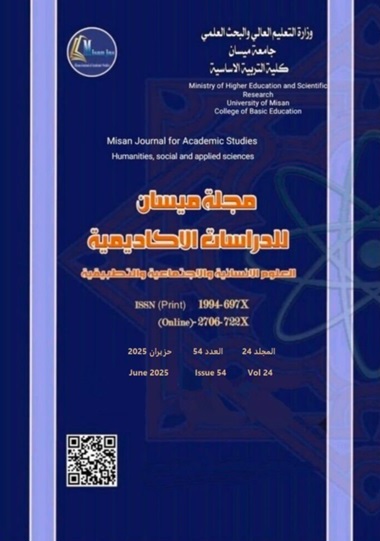Visual Art Methods and Techniques in Contemporary Art - American Painting as a Model
Abstract
The research, entitled "Methods and Techniques of Visual Art in Contemporary Art - American Painting as a Model," comprises three chapters. The first chapter includes the structure of the research's methodological framework, which includes the research problem represented by the following question: How have the methods and techniques of visual art contributed to shaping the features of contemporary American painting, and what is the impact of these methods on the visual and symbolic structure of artworks? It also addresses the importance of the research and its objectives, which were: 1. Identify the most prominent methods and techniques used in contemporary visual art. 2. Demonstrate the aesthetic and intellectual dimensions of these techniques. 3. Clarify the impact of technology and globalization on visual art in the modern era. It then defines the most important terms relevant to the research. The second chapter, which contains the structure of the theoretical framework and previous studies, consists of three sections:
- The role of contemporary technologies, such as 3D printing and digital art, in the development of American visual art.
- The concept of visual arts in contemporary art.
- Transformations of American Painting in Light of Social and Cultural Changes
The third chapter was devoted to the research procedures, which included: the research community consisting of (30) works documented in the artists' archives, their galleries, and the Internet, and the purposive sample of (3) works to represent the diversity and variety of techniques and styles of contemporary American painting. The chapter also included the research tool, which relied on indicators of the theoretical framework and observation. The fourth chapter was devoted to presenting the most prominent results, conclusions, and recommendations reached through the analytical study. The most prominent results were: 1- The emergence of a clear stylistic diversity in contemporary works, in terms of the use of graffiti, symbols, and vibrant colors, reflecting a visual development freed from traditional molds, the influence of technology and artificial intelligence in contemporary art, and the transformation of the recipient into an interactive element within the work, which enhances a new and shared artistic experience. In addition, the possibility of employing simple=-09876materials in innovative compositional methods while maintaining the aesthetic dimension, in an artistic overlap. Between modernity and expressive concepts. The paper then presents the most important conclusions and recommendations. The paper concludes with a list of references and sources
Downloads
Copyright (c) 2025 (Humanities, social and applied sciences) Misan Journal of Academic Studies

This work is licensed under a Creative Commons Attribution-NonCommercial-NoDerivatives 4.0 International License.
The copyright is also the copyright of the magazine only.
All articles published in our magazine are subject to license terms
Creative Commons Attribution(CC BY-NC-ND 4.0) This license permits the content to be reproduced, redistributed and reused in whole or in part for any purpose free of charge, without any permission from the author(s), researcher or student.
Works submitted to Maysan Journal of Academic Studies for publication in the journal (CC BY-NC-ND 4.0) license terms. Where available content can be shared, distributed and replicated provided there is no commercial profit and appropriate credit must be given to the original source through sources or citations. It is mandatory to review any material used from other sources including shapes, tables, and images for re-use under the terms of the Creative Commons License (CC BY-NC-ND 4.0).Provided that there is no modification to the original content



